Nigiri sushi is a sushi type famous in Japan, not only fresh, pure, each ball of oval rice makes you just want to enjoy it from the first time you see it. But how to make salmon nigiri is not easy!
Referring to sushi, people immediately think of Japan. The combination of small rice rolls and fresh seafood contributes to the famous Japanese language around the world. Sushi comes in different varieties according to preferences, climate, and domain name.
However, the most famous of these is still nigiri sushi. Nigiri sushi means hand-pressed. The ten that the first kitchen was used to be vo to the image of the beautiful eyes, sure and on is the products of well as, pure. How delicious nigiri sushi is entirely dependent on how well the rice is cooked?
With this article, we will provide you with the most useful and detailed information on how to make salmon nigiri!
This article contains:
- What Is Nigiri Sushi?
- Check Out The Indispensable Salmon Nigiri Ingredients
- A Raw Material To Make Salmon Nigiri
- How To Make Salmon Nigiri
- How To Choose Fresh Salmon And Seafood For Salmon Nigiri
- How To Eat Salmon Nigiri
- Food Prepared With Sashimi
Table of Contents
What Is Nigiri Sushi?
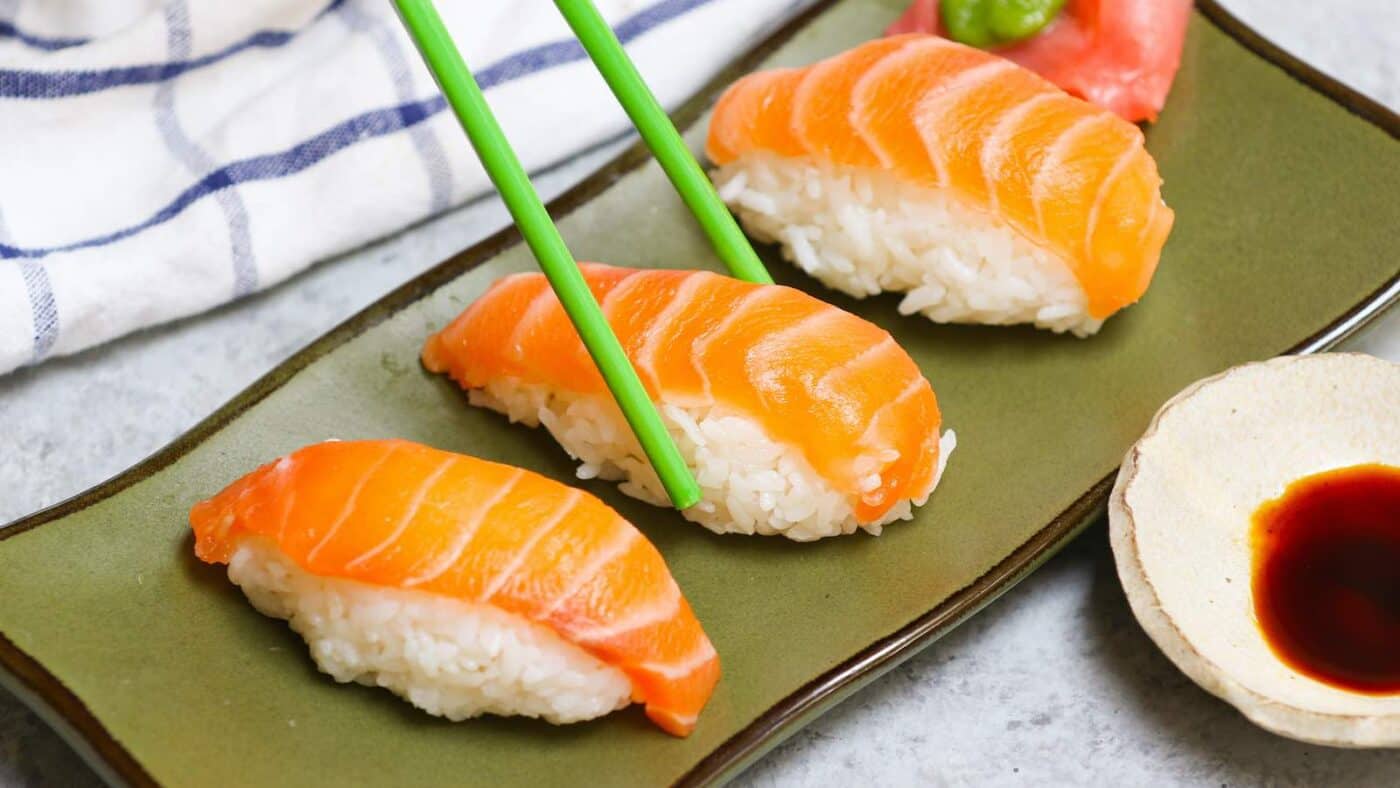
Nigiri sushi is a type of sushi with oval vinegar mixed rice, hand-pressed, topped with a piece of raw fish or fresh seafood (can be cooked) or fried eggs. How to make nigiri sushi meticulous in every little detail. Rice must be cooked from Japanese rice with just enough time, get out and mix with the vinegar mixture and let it cool. Fresh seafood is carefully selected, properly preserved, and sliced beautifully.
Eating Nigiri is also an art: first, you have to wash your hands, use your fingers to hold the sushi pieces gently dab the soy sauce and enjoy, you should not dip the rice but have to dip the seafood in the soy sauce. to fully feel the delicious taste of the sushi piece.
In addition, you can cook a variety of dishes in different ways such as Grilled salmon nigiri, Seared Salmon Nigiri (Aburi Salmon), Smoked Salmon Nigiri, Sockeye Salmon Nigiri, etc.
To make Nigiri sushi according to Japanese standards requires chefs to be highly skilled and manipulate extremely well. However, with the following simple method and cooking instruction video, you can still make delicious Nigiri sushi to enjoy at home.
Check Out The Indispensable Salmon Nigiri Ingredients
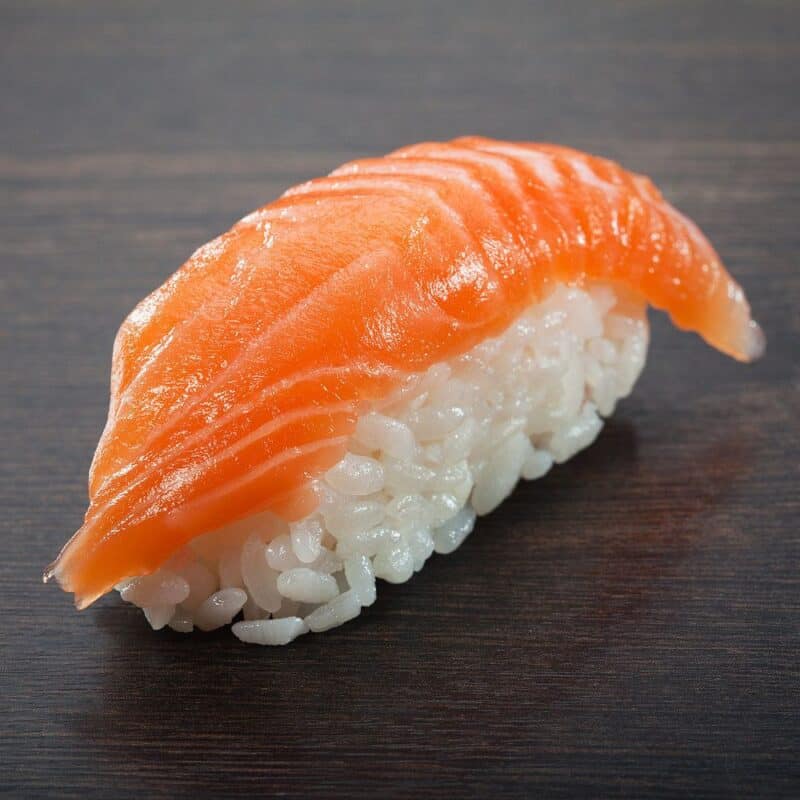
Are you trying to make sushi but don’t know what ingredients are needed? Let Moshi Moshi take a look at the variety of ingredients that make up this famous Japanese sushi.
To get the delicious taste that many users love, the ingredients that makeup sushi are always the finest products, carefully selected. Not only that, these are carefully selected ingredients that have certain benefits to the health of the user.
Japanese rice
Japanese rice has a round grain shape when cooked, creating a subtle aroma, Japanese rice is also very pliable, non-sticky, and has a very high adhesion so it is often used to make Sushi rice in Japanese restaurants.
No products found.
Especially Japanese rice products from the Akira Rice brand are the secret to creating delicious dishes of Japanese restaurants in particular and the world in general. The famous chefs at these restaurants rate the quality of the delicious Japanese Akira Rice on a par with their native rice. Akira Rice is proved to be a delicious and cheap rice product that consumers can rest assured to choose from for great family meals.
Seaweed
Sushi making is indispensable for all kinds of Japanese dried seaweed, with many different sizes, spoiled for you to choose to make large or small sushi. The thin leaves are not too tough but help create a “standard without needing” sushi.
In particular, this ingredient also adds essential nutrients to the body such as amino acids, vitamin b12, and minerals. Create a quality meal for your whole family. In addition to its unique flavor, the dried Japanese seaweed leaves also add to the appeal of famous sushi.
Salmon
The filling of sushi usually has a lot of options, but the most popular is fresh salmon. In particular, this fish must have a balance between meat and fat, mistakenly create sushi rolls that are fatty but equally sweet.
Especially salmon is considered one of the “golden” ingredients of the culinary industry because they possess extremely high levels of protein, Omega 3, 6, 9, DHA, EPA …. Besides, the taste and meat of salmon are also very suitable for sushi dishes that need freshness. Many chefs have chosen Norwegian salmon for their dishes because this is the best salmon variety on the market.
Spices for making sushi
The typical flavor of sushi is not only created from ingredients such as rice or seaweed, but also a combination of spices and sauces. A perfect sushi dish is indispensable for these spices.
Japanese vinegar is used to make sushi
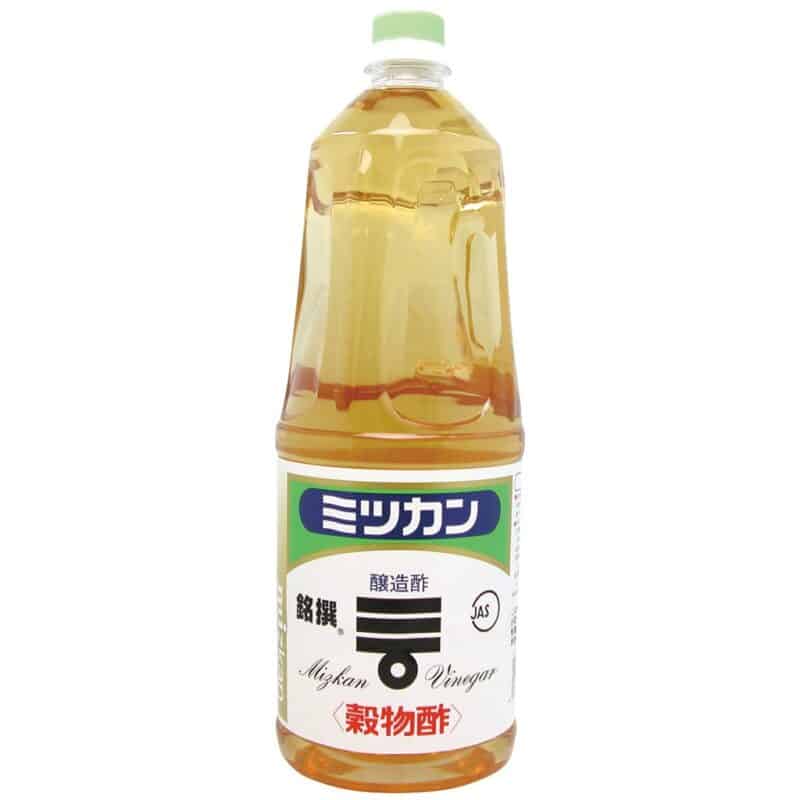
Japanese vinegar has a mildly sour taste, a sweet, light taste, and a glossy finish. Japanese sushi vinegar is already seasoned, so there’s no need to add sugar and salt. Besides, vinegar also helps to reduce fishy taste, sterilizes seafood to maintain the freshness of sushi.
Besides, Japanese vinegar also helps rice become softer and more pliable. Thereby increasing the cohesion of the rice so that when the rice rolls make sushi, the rice will not be broken or when dipped with soy sauce, it will not fall off the aesthetics. Not only that, but vinegar also helps the rice to increase the shine of sushi, looking very fresh and beautiful.
If you do not have Japanese vinegar at home or cannot afford it, you can also make your homemade sushi vinegar with very simple ingredients.
- Ingredients: White vinegar: 600ml, sugar: 500g, salt: 80g.
- How to do it: Add sugar, salt, and vinegar to the bowl and stir well. So you already have a vinegar mixture that makes Japanese standard sushi.
Sushi Soy Sauce
Soy sauce has a very important position in Japanese cuisine. Although the appearance of the soy sauce is quite uniform, if they are produced in different regions, the typical flavor, aroma, and salinity are not the same. Therefore, Japanese dishes, especially sushi, sashimi must be eaten with Japanese soy sauce to have a pure “indigenous” flavor.
No products found.
In Japan, in addition to the 5 main types of soy sauce that are divided into separate names, manufacturers also offer separate soy sauce lines for each dish. In which the most still must mention soy sauce to eat sushi. How wonderful your Japanese sushi will be if you enjoy the same wonderful traditional dipping sauce.
Mustard and pink ginger
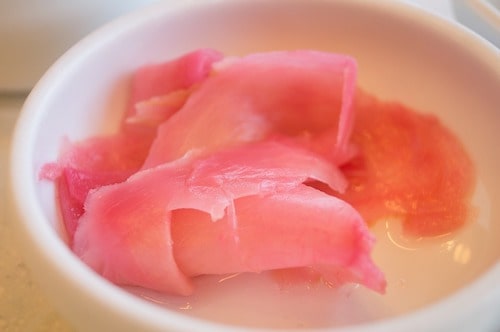
These are the two spices that come with sushi commonly found in Japanese restaurants. In addition to adding flavor to your dishes, they also help eliminate the fishy smell inside fresh ingredients such as seafood.
Besides, each type also has its effect to neutralize the ingredients in sushi, helping the digestive system “firmer”. It can be said that when using Wasabi mustard and pink ginger you will see “warm stomach” both literally and figuratively.
Also, the immune system-strengthening effect of Wasabi is very noticeable in Japan. Therefore, for them, Wasabi is not only a common spice but also an effective remedy in treating various diseases, especially digestive ailments.
In addition to the main ingredients to create sushi, the fish you can also create other types of sushi with ingredients such as:
- Ebiko Masago Shrimp Eggs
- Cucumber, avocado
- Crab stick.
- Japanese tuna.
- Or eat with other products such as:
- Edamame Japanese Soybeans.
- Herring pressed eggs.
- Enjoying with sake or apricot wine is even better.
A Raw Material To Make Salmon Nigiri
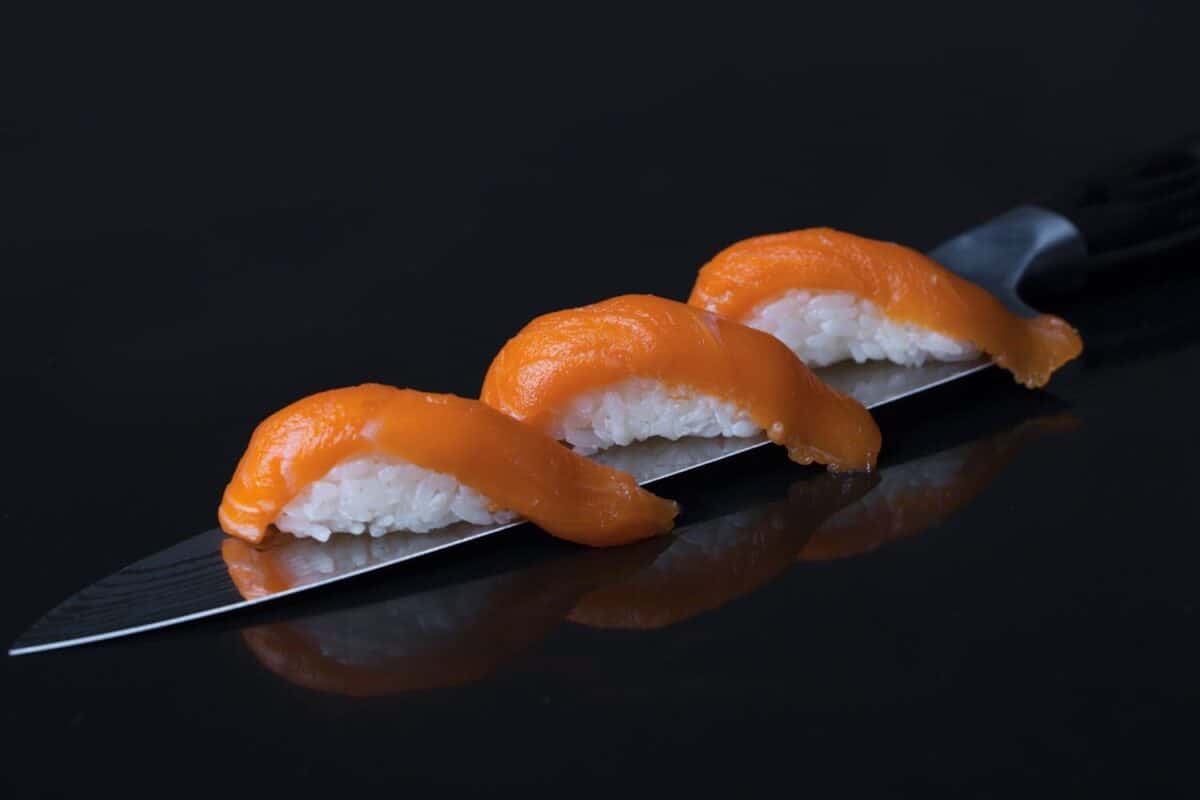
- 500 grams of Japanese rice
- 60 grams of tuna
- 1 scallop
- 10 grams of flying fish eggs or salmon
- Spices: Salt, sugar, Japanese vinegar
- 60 grams of salmon
- 1/2 red clam
- 20 grams of herring pressed eggs
- 550 ml of filtered water
How To Make Salmon Nigiri Sushi
Step 1:
Cut salmon, tuna, red clams, scallops, and herring into thin slices to taste. Note, you should use a knife very sharp and act quickly and decisively.

Step 2:
Wash the rice, then add 500ml of filtered water and let it cool
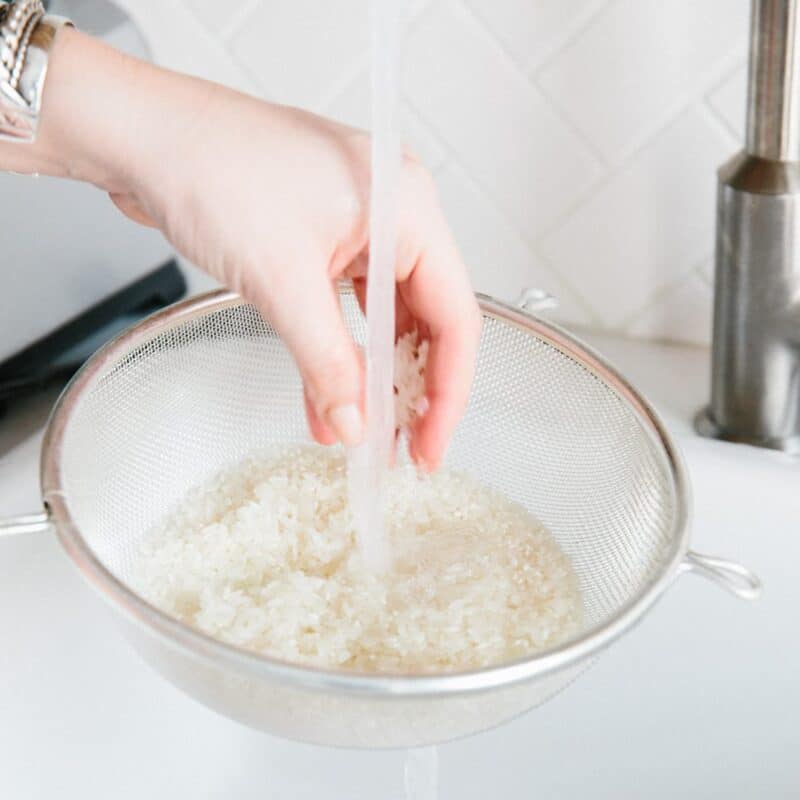
Step 3:
Mix well the spices including 7g salt, 50g sugar, 45ml Japanese vinegar. Then add it all to the rice and mix well.
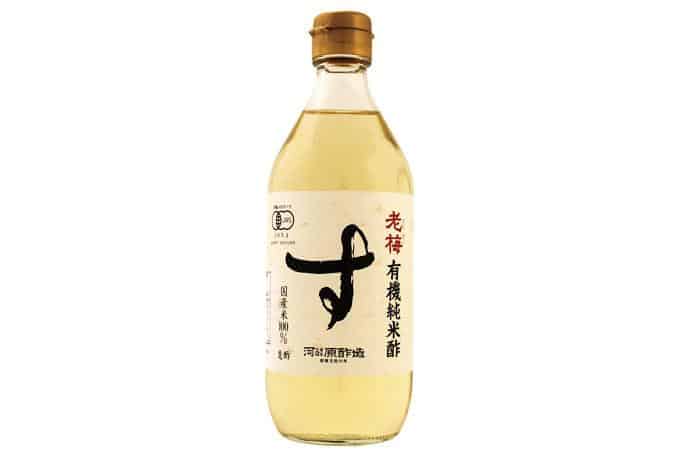
Step 4:
Use your hands to gently take the rice, little by little, then gently roll it into an oval shape. Note, you should often dip your hands in a bowl of cold water so that your hands are moist, the rice does not stick to your hands. After washing the rice, you put the fish on top and then lightly press the fish so that the fish cover the rice ball is fine. You can spread a little wasabi on the inside of the fish before pressing it on the rice. Finally, arrange the sushi on a beautiful plate and enjoy it. Sushi will be more delicious if served with wasabi and pickled ginger.

How To Choose Fresh Salmon And Seafood For Salmon Nigiri
Choose quality fish, sold at reputable establishments. If you can buy raw fish, it will taste better or you can choose to buy frozen fish. Remember to check the fish’s skin, if there are stains, do not choose because the fish may be sick.
When buying frozen fish, choose those that are stored in carefully shielded cans.
The flesh of the fish must be firm, bright, and elastic when pressed down. If the fish meat is soft, it is not fresh enough to make sushi.
Avoid using green, yellow, or dark-colored seafood on the meats, unless its nature is yellow like sea urchins. Check for unusually bright redfish. They may have been treated with pure carbon, giving the fish an unnatural red color.
Avoid shellfish with broken shells. Meanwhile, the shellfish has begun to be destroyed by bacteria invading.
Sashimi’s Complete Guide – what sets it apart from Sushi, ingredients, prices, and how to eat it
33 main ingredients for Sashimi in addition to tuna and salmon
Tuna
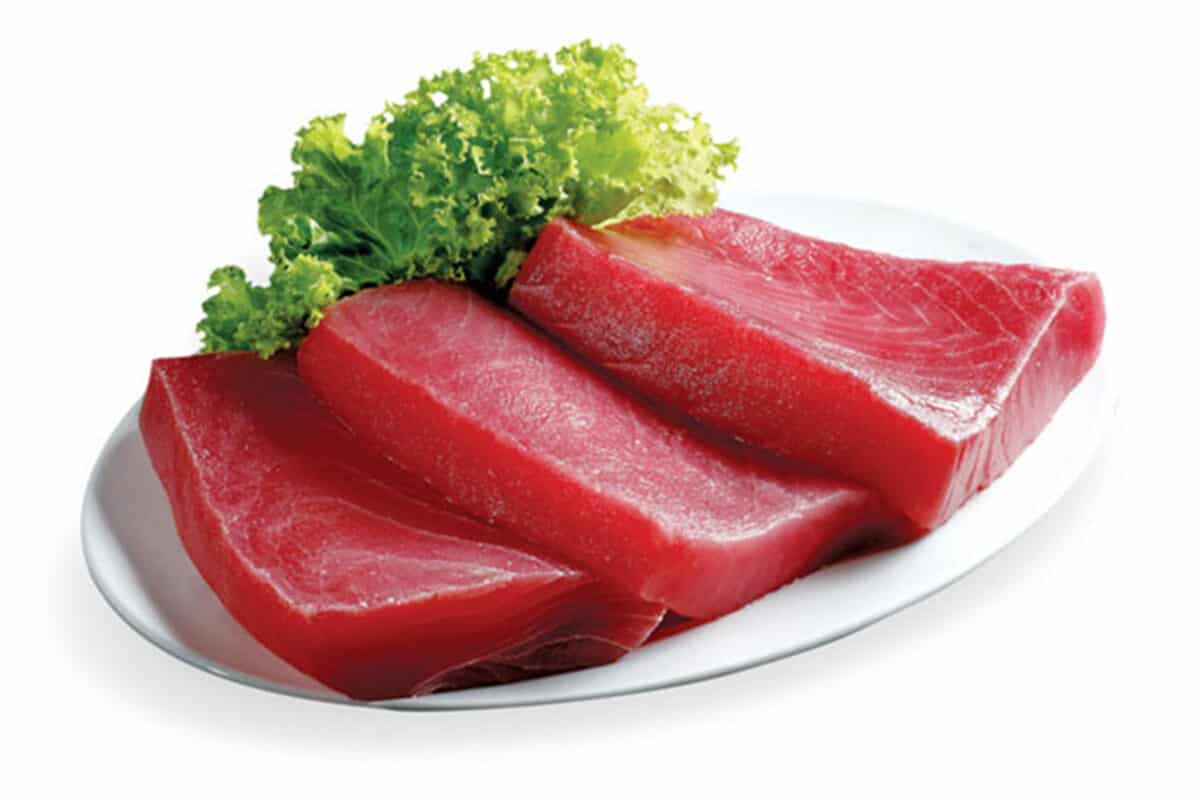
Tuna is food present in Japan since ancient times can be eaten raw as Sashimi, Sushi, or processed in many ways such as grilled, sautéed, or canned.
Also, the common name “Marugo” refers to red meat depending on the part of the fish (Akami). The particularly fatty cuts called Chutoro, Otoro, are characterized by pink flesh in comparison to the Akami portion.
The part of fish meat that is suitable for the masses of men and women is Akami. Followed by Chutoro and Otoro with increasing fat taste, some people like to have people not. The first time you try tuna, you should start with Akami.
Salmon
This is a fish dish that is very popular with women! The thick, rich flavor goes well with onions or mayonnaise, so it is often used in dishes like Makizushi.
Cuttle
Squid is also often found in Sashimi. The texture is soft and chewy, the taste is light, so it brings a feeling of delight when eating. Should be eaten with soy sauce and Wasabi.
There are many types of squid such as Yariika, Surumeika, … and according to which the taste is also different.
In terms of nutrition, squid is high in vitamin E, taurine, zinc, DHA, and EPA.
Octopus
Like squid, the octopus is also a familiar ingredient, has a mild flavor, and has a chewy texture. Besides Sashimi, the Japanese also enjoy octopus by boiling, making Takoyaki, …
Skipjack tuna
In Japan, there are many kinds of fish besides eating style like Sashimi, you can also cook Tataki way – double-sautéed. Northern-caught skipjack tuna is called Hatsugatsuo, it has a frugal taste; and the one caught in the south is called “Modorigatsuo”, which has a strong flavor.
Used as a raw material for Katsuobushi, skipjack tuna is so familiar in Japanese life that its characteristics quickly spoil, and vary greatly in freshness and flavor.
This is a specialty of the Pacific Ocean, including Kochi prefecture.
Japanese orange fish
Raised and caught long ago, orange fish is also one of the familiar fish breeds in Japan, classified as Shusseuo fish – meaning fish with different names depending on maturity.
The orange fish is loved when eaten in the form of Sashimi because of its firm and chewy meat.
In winter, the fish enter the period of spawning preparation, so the fat content increases, this is the time when the orange fish is the best and is called Kanburi. For the Japanese, orange fish is a winter fish that can be found regularly in markets and restaurants all year round.
For the rest of the year, the fish taste will be less delicious, so you must try it in winter!
Sea fish (Aji)
Can be caught from anywhere in the world, Aji is characterized by the flavor of both red and white meat fish. In Japan, the fish that is eaten mainly is Japanese mackerel, called Maaji, with a delicious taste, both light and sweet.
Sea bream (Tai)
Because the name is similar to the word Omedetai – meaning “Happiness” – the sea bream (Tai) is a fish that often appears in congratulatory meals. Like mackerel, sea bream also has a frugal and sweet taste.
Japanese grouper (Suzuki)
Suzuki fish is white meat fish and has almost no red meat. Legend has it that the name “Suzuki” comes from the fact that the fish meat looks clean like a mop (Susugu) of this fish. The flesh is like a sea bream, soft, sweet, and frugal. Suzuki fish season is summer, when the fat increases, improving the quality of meat. Also, there is no part of the fish that you cannot use, so you can make a variety of dishes.
Saber mackerel (Sanma)
Saber mackerel is considered to be a representative ingredient for Japanese autumn. When using mackerel as sashimi, to remove the fishy smell, people often use it with sliced ginger or apple.
Orange fish (Kanpachi)
The meat is firm and the fat is high, so many Japanese people like this fish. Orange fish living in the natural environment is a premium ingredient, but in Japan, farmed orange fish is also popular, so try it when you have a chance.
Mackerel (Saba)
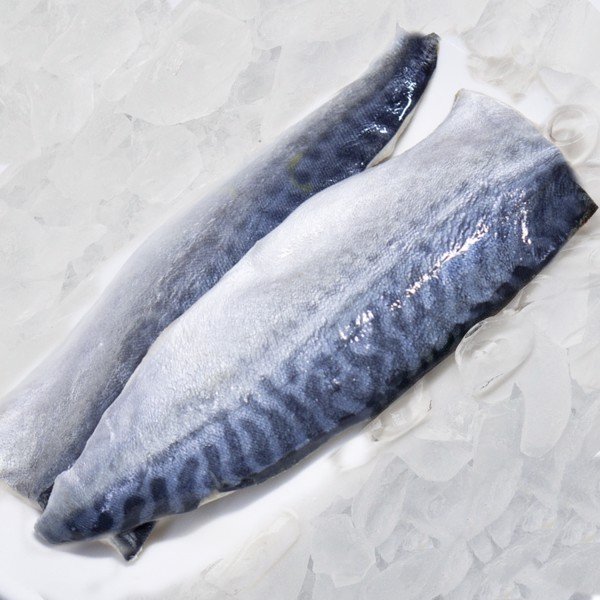
Mackerel along with tuna and mackerel are the most popular fish in the world and can be processed into a variety of dishes such as grilled, braised, Sushi, Shimezaba (* 1) or are also often packed. box. Japanese people rarely eat raw mackerel, but there are some excellent mackerel varieties called Burando-saba, which are extremely fresh and can be processed into dishes like Shimezaba or Sashimi. Also, this is a fish rich in DHA and EPA.
Pink shrimp (Amaebi)
Characteristics of Amaebi shrimp are pink or red body, soft shell is difficult to separate from the body. When eating raw, you will feel the sweetness because shrimp has a lot of amino acids such as glycine, alanine, … Because of the sweet taste, Amaebi shrimp is very popular with Japanese children.
Hokkigai scallop
Hokkigai oyster whose official name in Japanese is Ubugai is popularly eaten in Hokkaido and the Tohoku region (Northeast). This is a common ingredient of Sushi, nowadays Hokkigai clam is also very popular in the western Kanto region. Usually, Hokkigai oyster is served in a form that is removed from the shell and cooked and then kept cold, rarely eaten raw or with the shell, hardly seen by anyone.
Blood cockle (Akagi)
Mainly appearing in Sushi and Sashimi dishes, the Akagai is mentioned in “Ancient History (Kojiki)” – Japan’s oldest text. Crispy and lumpy eating is very delicious, so this is one of the scallops that are loved by the Japanese.
Scallop (Hotate)
In Japan, Hotate clams are widely caught for food but are now also raised for harvest. Hotate scallops are very popular among Japanese children and women due to their sweet taste due to their rich glutamic and amino acids, which are the ingredients that make up the umami sweetness.
Hemp (Uni)
The famous sea urchin is one of the Three Great Taste of Japan, has a salty taste, and is extremely warm of the sea. However, the sea urchin sold at the market is not freshly caught, with its original flavor that is usually treated with salt or alcohol.
In Japan, sea urchin is eaten raw in the form of Sushi, Sashimi, Union rice bowl, …
Salmon eggs (Ikura)
Salmon eggs, usually eaten raw by seasoning with salt or soy sauce. This is a dish familiar to families in autumn in Hokkaido. The interesting feeling of broken caviar in the mouth is the feature that makes this dish always on the menu of Japanese restaurants and is loved by diners of all generations.
Pufferfish (Fugu)
Like pufferfish Torafugu and Mafugu are also famous popular foods in Japan, especially Torafugu is known as a high-end food, with a very high price. Pufferfish are mainly found in the Kansai region in winter. The meat of this fish contains a poison that cannot be handled by normal cooking, so if an amateur does it, it will pose a lot of danger.
However, the taste is extremely delicious, especially the puffer fish intestine is highly appreciated by gourmets. Currently, pufferfish processors in restaurants must have certificates so you can feel secure to try them.
Koi carp
Although often appearing in artworks, Koi carp is also a breed of fish used to eat in the country of cherry blossoms. Most of the koi carp used to eat are from Fukushima prefecture and are often stewed in a sweet, savory, or sweetened taste. Also, there is processing by manipulation called arai, then marinated with sweet and sour Miso. Depending on the locality, some places like to eat such koi carp, but this way of eating has the potential to risk infection with parasitic diseases, so it is not popular.
Snail Sazae
The Sazae snail is one of the typical edible snails in Japan. When processed into Sashimi, snails sometimes have a bitter taste, so some people do not like this type of snail.
Abalone (Awabi)
Famous for being a high-end ingredient that is loved by the characteristic chewy texture when eaten. Depending on the region, there are places where abalone organs are considered a delicacy. Abalone is a material familiar to many countries around the world, used in dried form.
Herring herring (Kibinago)
Herring is also one of the ingredients used to make Sashimi. The fish body is translucent, has many small bones, but the amount of fat is low and the taste is very delicious. The Japanese often eat fish Kibinago with ginger, soy sauce, or sweet and sour Miso to reduce the fishy smell.
Horse (Basashi)
Along with Sashimi, Basashi is also a familiar dish in the Izakaya pubs of Japan. Basashi is not fish or seafood, but horse meat, eaten with herbs such as ginger, garlic, … Basashi has a warm taste and impresses with a stronger taste than other Sashimi types.
Sashimi from premium fish
Depending on the locality caught, the taste of the fish will vary despite the same type. The best-flavored fish are called Burando-go in Japanese and are highly regarded. Each locality has its unique delicious food, so you should try it out. Below is a list of some of the most famous super fish.
Tuna Oma (Aomori)
The first is Oma tuna from Aomori prefecture, famous for its beautiful color, rich flavor, and no market for freshness. Currently, this extreme fish is famous all over the world.
Masaba mackerel
Masaba and Maaji fishing off the coast of Saganoseki, Oita prefecture, are two famous fish in this prefecture. Unlike the common mackerel and mackerel which are migratory fish, mackerel and mackerel in the Saganoseki Sea tend to inhabit these waters. Masaba mackerel and Maaji mackerel in the Hoyo Strait basin have a superior taste and quality compared to other mackerel and mackerel.
Keiji Salmon (Shiretoko Peninsula – Hokkaido)
The Keiji Salmon is such a rare fish that people often compare it to an illusion. The number of catches per year is only about 480 individuals. Keiji Salmon is exceptionally high in fat, making it almost entirely of Toro meat.
Seitou mackerel (Kushiro – Hokkaido)
There is no characteristic fishy smell inherent in sardines, and the tender and fatty flesh like the Toro meat is characteristic of Seitou mackerel. This is a dish suitable for those who do not like the smell of fish.
Matsuwa mackerel (Miura Peninsula – Kanagawa)
Growing on the Miura Peninsula, Kanagawa Prefecture, Matsuwa mackerel has a round belly, fatty flesh, so it has a pale pink color like cherry blossoms, which is distinctly different from normal mackerel. Since July is the time when the fish are of the best quality, but due to the small catch, Matsuwa mackerel is very respected.
Serve with Sashimi
Sashimi is a dish familiar to all Japanese from a young age, but for foreign tourists, many dislike the taste and texture of fish. Meanwhile, use Sashimi with Yakumi – Japanese herbal spices.
To decorate the Sashimi plate, the Japanese often use seaweed and vegetables such as white radish and perilla leaves. Not only for decoration, but these vegetables can also be eaten with Sashimi, which is the factor that helps the Sashimi flavor become complete when enjoyed.
On the Sashimi shelves at the supermarket’s fresh fish stalls, you will also find the beautifully laid out Sashimi with vegetable ingredients. Most of the decorative ingredients for Sashimi are usually white radish and fresh seaweed, but also the seasonal vegetables and wild vegetables are abundant.
Also, among them are the Yakumi – herbal spices – that help enhance the flavor of Sashimi. Besides Wasabi – the classic herbal spice that is too popular with foreign countries, Yakumi also has ginger, apricots, yellow mustard …
How To Eat Salmon Nigiri
When eating Sashimi, there are no strict rules, you should first pour soy sauce into a small plate, then use chopsticks to pick up a piece of Sashimi, dab in soy sauce, and enjoy. That is fine.
How to use herbal spices
Perhaps many foreign visitors are confused by the use of herbal spices eaten with Sashimi.
Wasabi
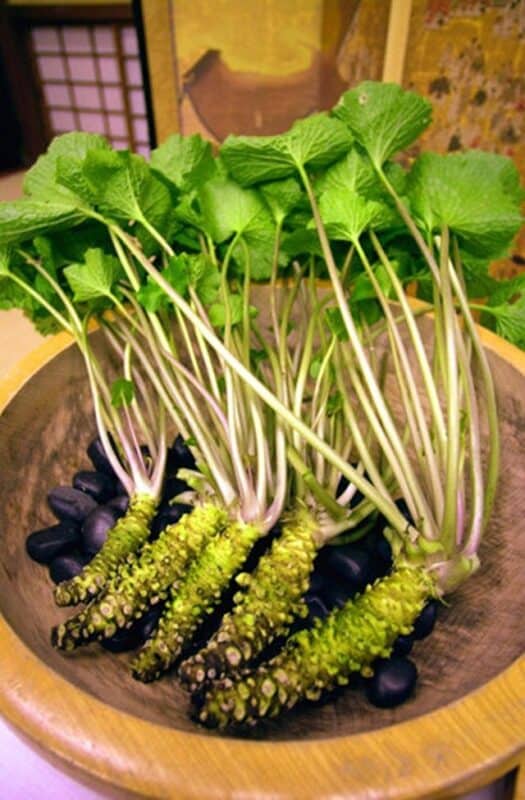
Spread a little Wasabi (about the size of a grain of rice) on Sashimi, dab in soy sauce, and enjoy.
Some people mix Wasabi in soy sauce and then dot, although nothing is against the rule, if you give Wasabi too much, the sauce will be very spicy. Furthermore, this way of eating will reduce Wasabi’s pungent taste and umami. So it’s best to just spread Wasabi on the fish.
Eating too much Wasabi, the pungent taste will cause tears and a runny nose, so please pay attention when you eat.
Children or those who are not good at eating spicy or not can spread Wasabi.
Ginger
For mackerel or skipjack tuna, the Japanese eat with ginger, instead of Wasabi. The way to eat is similar to Wasabi and should not add ginger to a plate of soy sauce.
The nutritional content of Sashimi
Sashimi is a very delicious dish but it gets even better when you care about its nutritional content. Traditional Japanese cuisine Washoku is inherently lower in calories than Western European and Chinese cuisine, however, the actual number is. Let’s take a look at some famous ingredients.
The number of calories that a person normally eats, in grams (g)
- Tuna / Akami 30g 38kcal
- Sea fish 25g 30kcal
- Scallop 25g 24kcal
- Squid 25g 22kcal
- Pink shrimp 3 pieces 15g 13kcal
This is followed by the calories and volume of ingredients common in Sashimi.
- Tuna / Toro 30g 103kcal
- Mackerel 25g 78kcal
- Orange fish 30g 77kcal
- Sardines 25g 54kcal
- Mackerel 25g 51kcal
- King salmon 25g 50kcal
- Sea bream 25g 49kcal
- Skipjack tuna (autumn) 25g 41kcal
- Flounder 25g 31kcal
- Grouper 25g 31kcal
- Skipjack (spring) 25g 29kcal
- Shellfish 25g 25kcal
- 25g 25kcal octopus
- Shrimp volume of 5 25g 25kcal
- Pufferfish 25g 21kcal
- The comedy 25g 21kcal
- Silly fish 25g 20kcal
- Hokkigai oyster 25g 18kcal
- Blood cockle 3 24g 18kcal
Food Prepared With Sashimi
Sashimi Salad
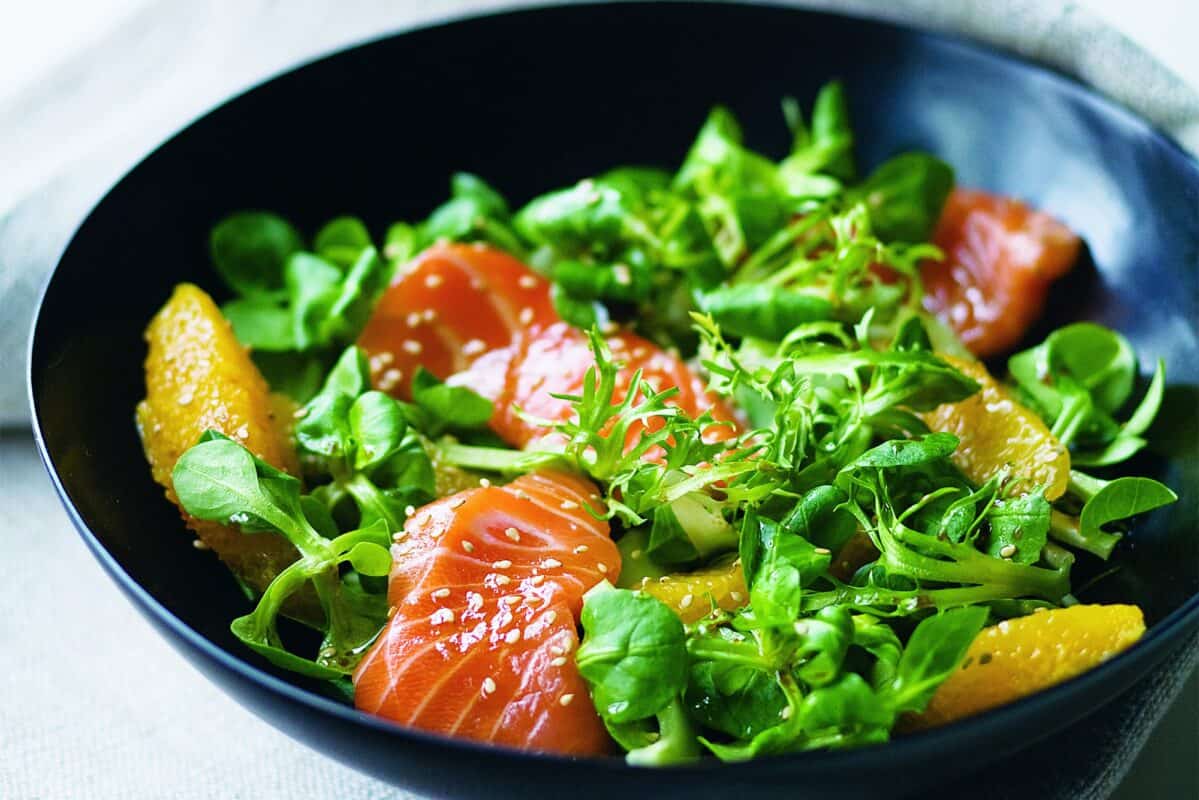
A popular Sashimi-based dish is Sashimi Salad with Sashimi arranged on top of vegetables. You can enjoy the food at Izakaya restaurants when you come to Japan. This dish has a healthy appeal, as you can eat slices of Sashimi along with vegetables. Also, the dish will taste better when eaten with a sauce blended from rich soy sauce or spicy Wasabi.
Sushi
The most famous dish using Sashimi as an ingredient is Sushi. There are many types of Sushi such as Nigiri Sushi – vinegar rice with Sashimi on top, Chirashi Sushi – vinegar rice mixed with ingredients, or Makizushi – vinegar rice rolled with all kinds of filling, …
Tataki
There is also a way to prepare a dish called Tataki, cut ingredients into small cubes of 1-2cm, mix with Miso and herbs, and mix and chop. Tataki is also the name for another type of cooking as follows, cutting the ingredients into cubes and then pre-baking over the heat so that the ingredients are just cooked. Tataki is often served with mackerel or skipjack.
Not only Sashimi, by adding a few variations you can already enjoy the much better fish and seafood dishes.
Conclusion
The key to making perfect nigiri is fresh fish and rice that has been cooked just enough. Once you’ve got the hang of it, your skills will improve quickly! Keep in mind: cooler temps produce better results (and shorter preparation times).
Now there is no need to go to remote Japan or spend a lot of money to enjoy nigiri sushi at large restaurants, you can completely prepare this dish at home with a delicious taste with our guide for how to make salmon nigiri. Good luck! See us more with some other articles!
| Read Also: 19 Best Dishwasher Safe Steak Knives Review: Which One Is The Perfect Choice For You? Top Quietest Undercounter Refrigerator For Home, Bar And Accommodation Service |
G Patel has been honing his craft in the restaurant industry for over 25 years. After graduating from North Carolina State University with a degree in business, G set out to turn Eschelon Hospitality into a recognized brand throughout Carolina’s state restaurants; and he did just that when acquiring Mura North Hills. Since then, it has become an iconic sushi-serving establishment.

